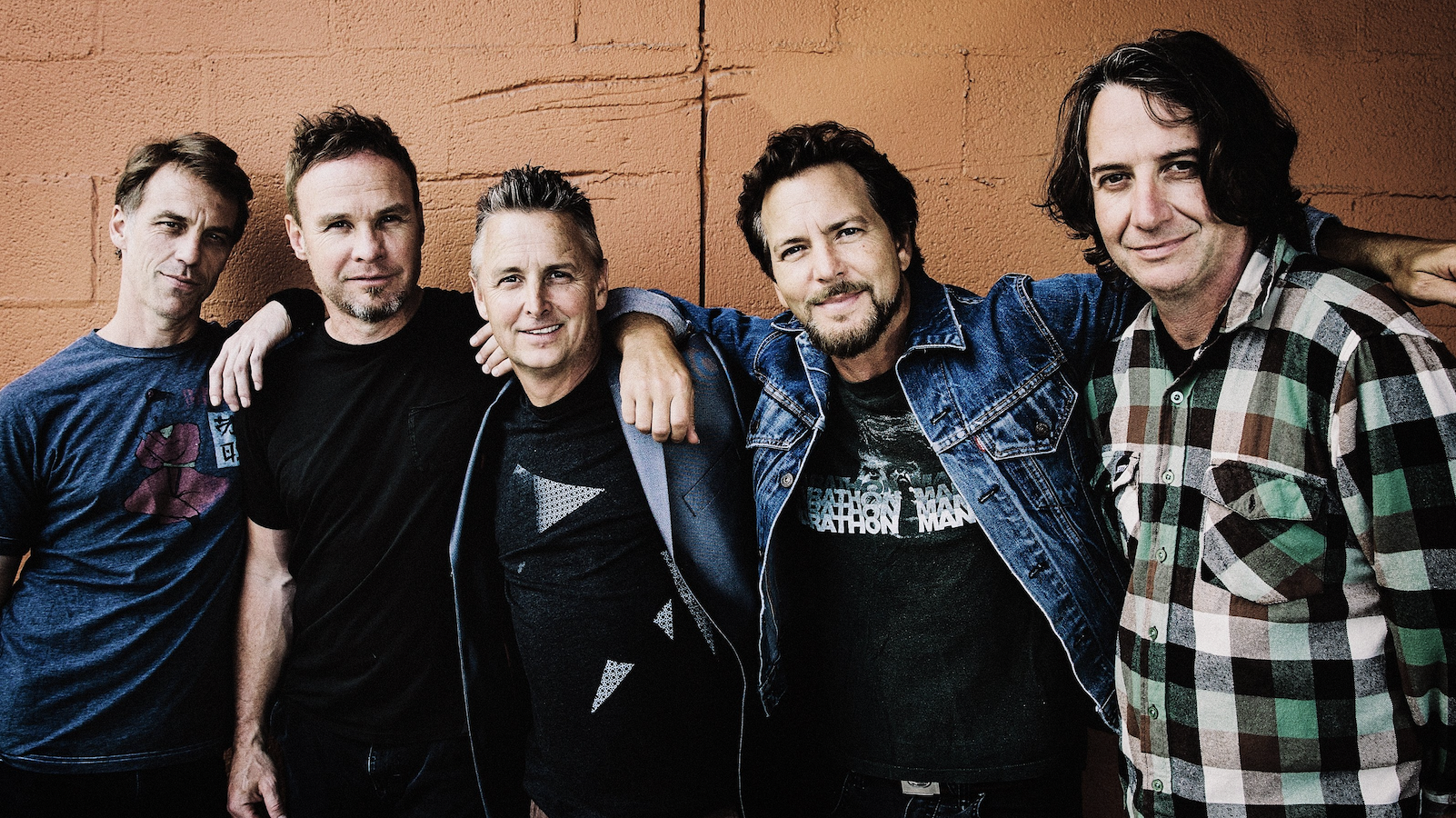Pearl Jam’s Mike McCready on teaming up with Fender to recreate his prized 1960 Stratocaster
Now that we’ve all had a chance to soak in the wicked riffs that pillar Gigaton, Mike McCready is giving us a chance to shred them out for ourselves, thanks to his new signature Fender Stratocaster

On their own respective accords, the words ‘custom’ and ‘shop’ are both very lucrative terms to any dedicated guitarist. Put them together, however, and watch the ears of any shredder with a spending problem prick up faster than a labrador at dinnertime. The Fender Custom Shop is a venerable Valhalla for gear nerds, with some of the world’s best luthiers forging monumental works of amp-ready art on the daily. And one extremely popular aspect of their craftsmanship lies in the recreation of classic guitars made iconic by some of music’s most illustrious names. Like, for example, Mike McCready of Pearl Jam.
After knocking it out of the park with his riffs on last year’s critically adored Gigaton album, McCready is continuing his six-stringed lightning streak with a (super limited) Custom Shop build of his classic 1959 Stratocaster… Or, well, so was the intention. Y’see, McCready bought the guitar in 1991, enamoured by the virtuosic playing of Stevie Ray Vaughan on his own ’59 Strat. And by all reasonable knowledge, McCready thought he was picking up the exact same model – that’s what it said on the tag, at least. But only after Fender borrowed the guitar to spec it up this year that it came to light his Strat was actually a 1960 model.
This wouldn’t normally be a big deal, of course, but for McCready – who has the number 59 tattooed on himself in dedication of the axe… Well… Yeah.
Nevertheless, McCready’s 1960 Stratocaster is an absolute marvel, and the Fender Custom Shop have done an inhumanly kit-accurate recreation for their release. We caught up with the man behind the madness himself to discuss the origin story behind this beloved behemoth of a guitar, why certain guitars are simply more special than others, and how master builder Vincent Von Trigt made the ultimate doppelgänger of the Strat that never stops.
Do you remember when you first got your hands on this Strat?
All those years ago… It’s a little blurry for me. Let’s just say I was more of a partier back in my early 20s [laughs]. It was right around when we first started having some success, so just prior to 1991. I played it at our first show with Keith Richards in ’91 – we opened up for the Stones in New York, and that’s the first time I ever brought it out with me. I bought it right before that show, I believe at Danny’s Music in Everett, in Seattle, and I think it was something like $7,000 back then.
And it was very significant – the only guitars I had prior to that were a ’62 Strat, which Jeff [Ament] and Stone [Gossard] got for me, and I had a Telecaster and an acoustic. So this was a big deal – it was my first, “Okay, I’m going to spend some money on a really nice guitar” moment. I wanted a ’59 Strat because Steve Ray Vaughn played it, and y’know, he was my guy at that time – and still is to this day. It played perfectly when I picked it up that first time, and it’s played that way ever since.
Do you find that Strats make for good workhorse guitars on the road?
I feel like I’ve always heard Telecasters be called the workhorse – Springsteen’s got one, Joe Strummer has one, Eddy [Vedder] plays them… I’ve got a couple Teles as well, but for me personally, that ’60 Strat is my go-to. I always use it on “Even Flow”, I use it on “Star Spangled Banner… I used it on one of our new songs, “Dance Of The Clairvoyants”, and I used it specifically for that song because I knew I wanted that sound. That guitar will deliver the sound I’m thinking of 99 percent of the time.
Get The Pick Newsletter
All the latest guitar news, interviews, lessons, reviews, deals and more, direct to your inbox!
Do you feel like certain guitars inspire creativity, or help the songwriting process more than others do?
Yes, I do. If we go all the way back to Ten, thinking about what I was going to play underneath Stone’s riff on “Alive” – he was on a Les Paul and I had, at that time, my black Stratocaster, and the idea for my part came out of what the Strat sounded like. Because I wanted to have something that was not exactly like Stone’s riff, but rather supported it – something that was kind of mellow during the first and second verse, but when it kicks in for the chorus, would let me pick up all the volume and have my Strat duel his Les Paul. And I think guitars do that, y’know? I have a certain acoustic that I like to learn things on, too. I can think about what kind of sound I want, but I have to feel it in a guitar to get it out.
Some guitars just have a unique character.
Exactly – it’s the character, it’s the colour, it’s the feeling of the sound. Does it scream in a solo? Can I get feedback on it? Can I control the grunt? Can I make it really light and relaxed? And I can do all of that with my ‘60 Strat.
Have you made any customisations to that guitar since you bought it?
It’s exactly how I got it, except that I’d broken the tremolo bar a bunch of times. I believe the pickups are all original; some of the knobs might be original, but I don’t think they are; and the tuning pegs are not original. That’s how I approach guitars in general – I’m not precious with them, y’know? I mean, I let people come over to my house and play my guitars all the time. I’m like, “Yeah, you can play that $10,000 guitar,” and they’re like, “Are you sure?” And I’m just like, “That’s what they’re for!”
So what was it like teaming up with the Fender Custom Shop to recreate it?
I got a call and George Webb, who’s the head of our old warehouse and Jeff’s bass tech – he got a call from Michael Schulz at Fender asking if I wanted to do a model of my “1959” Strat. I was like, “F*** yeah, that sounds amazing!” He came up with another guy – I forget the name of the other gentleman, but they looked at it and looked at all the other Strats I have – a ’57 and a ’58 – and the ‘60 was the one that they were the most interested in. And I can see why – it’s a perfect guitar!
Michael was very easy to deal with – he’s an artist relations guy, he knows about music, he plays guitar himself… And I got to go out to the Fender factory and look at how the whole operation runs. I got a tour of the factory and got to meet the master craftsmen… It’s truly unbelievable how they do everything – from the wood, to the machines, to the drying of the paint. But it was also a very easy process.
Were you very hands-on with Vincent Van Trigt and the Custom Shop team?
George and I were pretty hands on with Vincent – who really did a phenomenal, unbelievable job on this guitar. I remember when George got the first prototype in; I played it through a couple different amps, and there were a few things I wanted changed: I wanted the neck to be a little smaller and form to my hand like it does on my original Strat – and Vincent had no problem with that. There were a couple of cosmetic things, like making more dents in it and scratching it up a bit more… So it went back and forth… Actually, I think just that one time.
That’s the thing about Fender: they’re very efficient, but it’s not like an uptight or rushed efficiency – they just get their shit done, and you get your product very quickly. And it’s perfect. And so when I got it back the second time, I had taken it and put it right next to my original one, I left the room and went and did something, and when I came back in, I grabbed it thinking it was my real one. So I’m playing it and just going, “Oh shit, wait a second!” That happened three times – three separate times, too. That should tell you how meticulous Vincent’s work is.

Ellie Robinson is an Australian writer, editor and dog enthusiast with a keen ear for pop-rock and a keen tongue for actual Pop Rocks. Her bylines include music rag staples like NME, BLUNT, Mixdown and, of course, Australian Guitar (where she also serves as Editor-at-Large), but also less expected fare like TV Soap and Snowboarding Australia. Her go-to guitar is a Fender Player Tele, which, controversially, she only picked up after she'd joined the team at Australian Guitar. Before then, Ellie was a keyboardist – thankfully, the AG crew helped her see the light…
“What blew me away was that everyone wanted the curly maple top. People were calling, saying, ‘I’ve got to have the bird inlays’”: Paul Reed Smith on raising the Standard 24, finally cracking the noise-free guitar and why John Sykes is a tone hero
“It combines unique aesthetics with modern playability and impressive tone, creating a Firebird unlike any I’ve had the pleasure of playing before”: Gibson Firebird Platypus review




![[from left] George Harrison with his Gretsch Country Gentleman, Norman Harris of Norman's Rare Guitars holds a gold-top Les Paul, John Fogerty with his legendary 1969 Rickenbacker](https://cdn.mos.cms.futurecdn.net/TuH3nuhn9etqjdn5sy4ntW.jpg)





